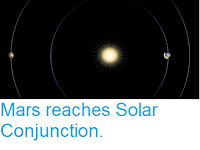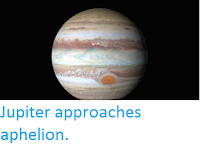The planet Neptune will reach opposition (i.e. be directly opposite the
Sun seen from Earth) at 5.13 am GMT on Tuesday 5 September 2017. This
means that it will both be at its closest to the Earth this year, about
28.96 AU (28.96 times the average distance between the Earth and the
Sun, or about 4 332 000 000 km), and completely illuminated by the Sun.
While it is not visible to the naked eye observer, the planets have
phases just like those of the Moon; being further from the Sun than the
Earth, Neptune is 'full' when directly opposite the Sun.
Since the orbits of the planets are not in complete alignment, Neptune
will not be completely behind the Sun at conjunction but passes within
50
arc minutes of it (the sky, imagined as a sphere around the Earth, is
split into 360 degrees, and each of these is split into 60 arc minutes),
though this still means it cannot be observed due to the glare of the
Sun.
See also...
Follow Sciency Thoughts on Facebook.







